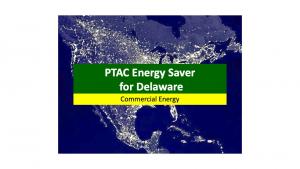
TIME TO ACT: Save 20% or more on HVAC. It’s important now more than ever for a sustainable future!
Optimizing PTAC units with a “smart” device is a fast, easy, and cost-effective way to achieve Commercial HVAC Energy Savings. A Packaged Terminal Air Conditioner is a type of self-contained heating and air conditioning system commonly found in: Hotels, Motels, Senior Housing Facilities, Hospitals, Condominiums, Apartment Buildings, and Add-on Rooms & Sunrooms.
Business owners and homeowners face increasing challenges with energy costs to save energy and money in Delaware. PTAC Energy Saver offers an Adaptive Climate Controller (ACC). It is a proven HVAC energy saving device that quickly installs on PTAC units. There are many companies that claim to produce energy savings, but the ACC device is multi-panted and proven over many years. Plus, it has extensive validation tests by organizations such as:
- ConEdison, Manhattan Plaza New York City
- Environmental Test Laboratory, Ohio
- EME Consulting Engineers (Third Party), Sponsored by NYSERDA, New York
- State University of New York, Oneonta, NY
- Tim Garrison (Third Party Testing)
- McQuay Cooling Tests
- Purdue University Tests (Phoenix)
- ConEdison Tests by ERS
Typically, when an HVAC system turns off, shortly after, the blower fan motor turns off. The ACC reprograms the blower fan not to shut off but to throttle back the rpm airflow to an exceptionally low speed, quiescent level airflow or “idle speed”. This allows for a gentle but continuous air movement into the building that helps keep equilibrium of climate conditions in the occupied space and saved energy.
PTAC Energy Saver can help you navigate the complexity of HVAC energy saving choices: CONTACT PTAC Energy Saver
Here is an example of some Commercial HVAC Energy Saving info for Delaware:
Delaware Building Energy Codes Receive Update
An update to the state’s building energy codes that took effect this month will help reduce long-term costs to consumers while also decreasing greenhouse gas emissions in Delaware.
Energy codes establish minimum design and construction requirements for energy efficiency in buildings, including insulation, air leakage limits, lighting and heating and cooling systems. The standards increase building sector energy efficiency, deliver energy cost savings to building owners and occupants, increase occupant comfort and reduce greenhouse gas emissions in Delaware.
The update introduces energy efficiency improvements, including increased residential air sealing requirements, hot water pipe insulation and energy efficient windows and lighting options, as well as more efficient heating, ventilation and air conditioning (HVAC) system operation resulting from improved duct design and sealing, energy efficient windows and lighting options.
“The adoption of these updated standards is an important step in helping Delawareans reduce their energy costs,” said DNREC Secretary Shawn M. Garvin. “It will also help us toward meeting our goal to reduce greenhouse gas emissions.”
Governor John Carney has committed to reducing the state’s greenhouse gas emissions by at least 26 percent from 2005 levels by 2025. Electric power generation is among the top three sources of greenhouse gas emissions in Delaware

